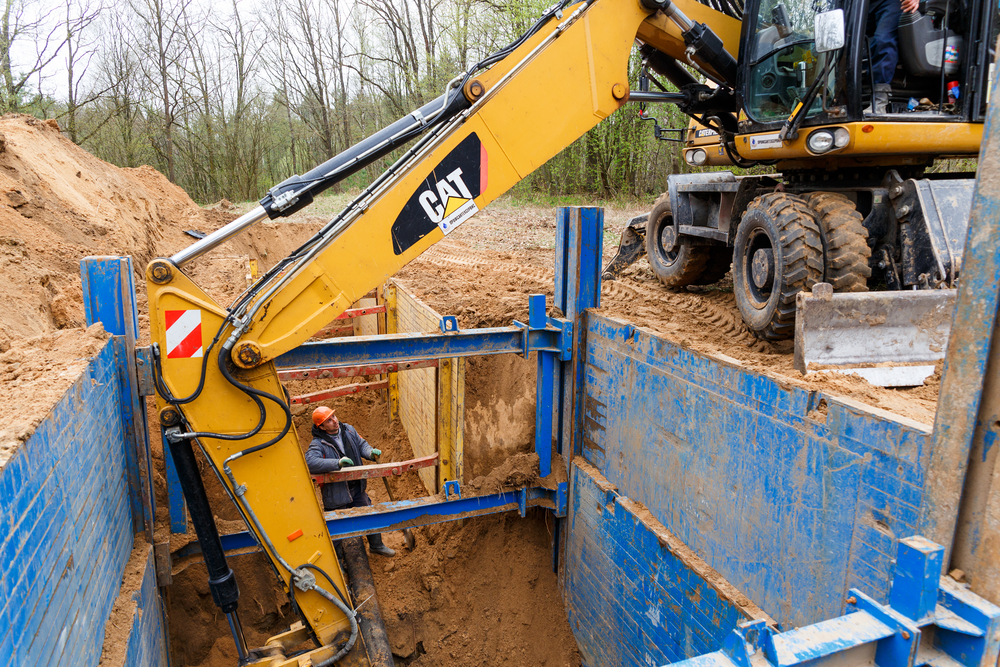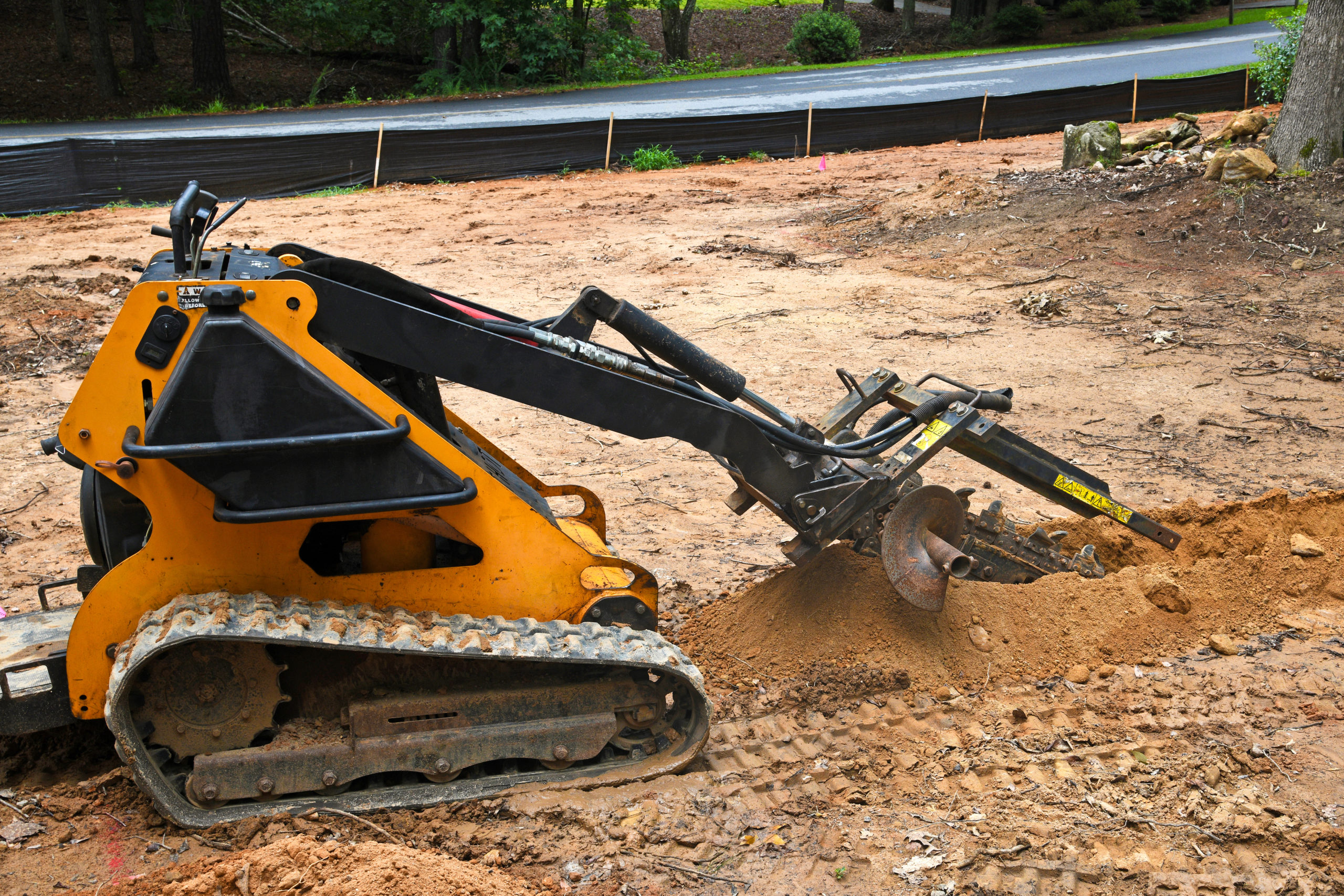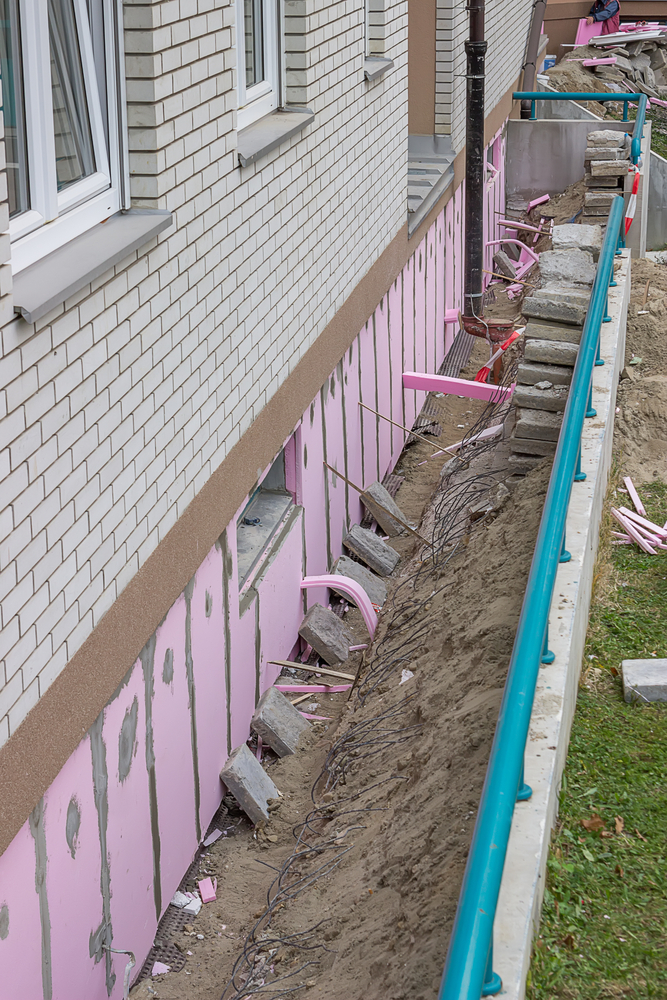When trenchers were first introduced to the residential and commercial contractors, they rapidly became the backbone of the crew. The time and labor trenchers saved when they replaced the pick and shovel was simply incredible. The contractor was able to double the number of jobs his crew could complete in the same amount of time – or less. Trench work & fill dirt go hand and hand. As a direct result of your trench work, you will probably generate fill dirt. This fill dirt will need to graded or hauled off site. Make allowances for your excavated spoils with your trench work.
The standard types of trenchers, whether dedicated units or attachments, they are versatile machines for contractors to have with them on the job. They can be used for many different purposes, from digging valve box holes to trenches for drain pipes. In areas that contain rocky soil, large roots, or other problems where the other machinery can’t access the soil, the trencher will minimize downtime that was once spent digging by hand.
The many types of vibratory plows will offer even more labor saving options. These plows eliminate the hand labor of having to lay the pipe and back filling on numerous jobs. Even though vibratory plows have taken their market share and are great for pulling pipe, trenchers are still very important for many different types of applications. The impressive company Bobcat offers three different trenching attachments that are designed for use on the smaller skid steer loaders. The attachment models LT102, LT203, and LT304 all have digging depths from 2 – 4 feet.
Mini Trenchers
The mini trenchers have been re-designed and finely tuned from the same concept that made standard trenchers so popular. As the name suggests, they are lightweight, with the largest models weighing less than 400 pounds. They are also compact, allowing you to put them in the back of an average pickup truck.
They will also dig a trench around 4 inches wide, and up to 13 inches deep, neatly laying the soil on side of the trench. Without any trouble at all, you can cover pipe with the backfill, leaving
a barely visible seam in the soil.
With time being money, these types of mini trenchers are the answer when working in tight or small areas, or on jobs that have a lot of trees or shrubbery. Mini trenchers have a turning radius of less than two feet and they will easily fit through most garden gates. Jobs that would normally need a lot of manual labor will now save you a lot of time and man power.
You won’t need a lot of labor with a trencher, as you can do most of it yourself. For saving time, money, and effort, trenching and plowing equipment is the way to go.
Trench Safety
In July, OSHA unveiled a free sticker intended to remind workers of the three primary protective systems:
- Sloping (or benching). Cutting back the trench wall at an angle inclined away from the excavation.
- Shoring. Installing aluminum hydraulics or other types of supports to prevent cave-ins.
- Shielding. Using trench boxes or other supports to prevent cave-ins.
Types of Shoring
Trench Shoring is a method of construction not often talked about, but usually employed in most projects. Whichever kind of shoring is needed, the process includes temporarily supporting a structure that would be otherwise unsafe. In a shoring project, teams create a temporary structure that supports a hazardous area for use during the length of construction. Once the team completes the project, they can remove the structure.
Vertical Shoring
Vertical shoring is a method of shoring that protects excavation using hydraulic pressure to support trench walls and prevent cave-ins. One of the lightest and most accessible shoring types, vertical shoring is installed or removed from the top of the trench using linear trench applications. Once installed, the vertical shoring equipment allows for the commencement of utility installation, unconventional pit application, repairs, inspections, and other construction projects.
Trench Box
When it comes to digging trenches, you must have what you need to do so safely. Trench shoring materials could make the difference between success and failure, especially when it comes to worker safety. Fortunately, trench boxes provide you with the support needed throughout the length of your project. In fact, trench boxes are one of the strongest and most robust types of shoring available.
Timber Shoring
Timber shoring is another type of shoring designed to protect workers and prevent cave-ins. The concept behind timber shoring is fundamentally different than aluminum and steel excavation shoring systems. Timber shoring is suited well for excavations with significant construction time. During this shoring process, workers need specific timber. Not all timber work for shoring, and these materials must be free from damage or defects. The wood must also maintain its condition and be continually inspected and removed from service if damaged.
Top 5 Excavation Safety Hazards
Trench collapses kill an average of two workers every month, making this a serious threat to worker safety. To prevent cave-ins, OSHA requires a professional engineer or a qualified professional to analyze soil composition, and then design and implement a system that:
- Prevent Cave Ins
- Clearly Mark Trenching Area & Avoid Falls & Falling Loads
- Atmospheric Testing To Avert Hazardous Atmospheres
- Flagger Directions For Mobile Equipment
- Contacting Ms. Utility Prior To Trenching
Additional Trench Work Information
- Know the lay of the land.
- Contact Ms. Utility before you dig.
- Create a construction and safety plan.
- Organize machines and all equipment
- Account for all equipment prior and upon completion of work.
- Begin trenching.
- Remove dips and humps.
- Clean up site.
- Install cabling, pipes or drainage.
- Backfill area as per plan or established grades.
Trench Safety
According to OSHA, general safety measures to follow should cover the following:
- Inspect trenches daily before work begins. Don’t go near an unprotected trench.
- Check weather conditions before work, be mindful of rain and storms.
- Keep heavy equipment away from trench edges.
- Be mindful of the location of utilities underground.
- Always wear proper protective equipment.
- Don’t work beneath raised loads.
- Conduct atmosphere tests. If low oxygen and toxic gases were detected, workers must not enter the trench.
- Protective systems like benching, sloping, shoring and shielding must be created.
- Planning and implementation of safety measures must be done by a competent person.
- Use a checklist to perform regular self inspections – download free excavation safety checklists here.
Trench Work & Fill Dirt
The process of putting the soil back into a trench or foundation once excavation is called backfilling. The backfill process requires skills and heavy equipment as well as knowledge of the specifications, contract requirements, and soil conditions. Every area of soil has unique characteristics, requiring different construction techniques to ensure optimum performance. Often times you must place the fill dirt material in layers (lifts) and compact. After compaction, you can install additional material. Repeat this process till you reach your determined grade.
Trench Compaction
The general process follows three steps that are repeated until the backfill are is at grade level:
- Backfill in layers of 4 to 6 inches
- Compact backfill material appropriate compactor equipment
- Apply moisture to backfill material during placement and compaction
It is at this time you must make allowances for the remaining clean fill dirt from your trench work & fill dirt. Dirt Connections is a great source to buy fill dirt due to our many projects.
Efficiently Managing Fill Dirt During Trench Work
When performing trench work, it’s essential to plan for the fill dirt generated during excavation. Efficiently managing this material involves backfilling in layers, compacting each layer with appropriate equipment, and adding moisture as needed to ensure proper compaction. This process helps to avoid settling issues later. Additionally, any excess clean fill dirt should be accounted for and either graded on-site or hauled away. Proper handling of fill dirt ensures a smooth and successful completion of your trench work project.
Summary

Dirt Connections was started with one goal in mind: providing quality residential and commercial construction services to clients on time and on budget. Reach out for more information on how we can support your next project.
For your convenience our estimates are free and by appointment. Call 703-940-9949 for a free estimate today!















































